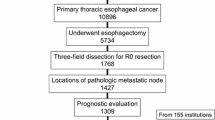Summary.
Similar to other tumor entities, complete tumor removal with an adequate safety margin in all three dimensions (the oral margin, the aboral margins and the tumor bed) must be the primary aim of any surgical approach to carcinoma of the upper gastrointestinal tract. The same goal has to be achieved in the area of the lymphatic drainage. All positive nodes and nodes with a so-called ’microinvolvement' have to be removed together with the primary tumor. The safety margin of lymphadenectomy can be estimated by the lymph node ratio, i. e. the ratio between the number of removed and positive nodes. Several studies have shown that for carcinoma of the upper gastrointestinal tract the prognosis can be improved markedly if the lymph node ratio is below 0.2. For tumors in the early phase of lymphatic metastasis this can be achieved by extensive lymph node dissection. In practice, this requires as a minimum a lymphadenectomy of compartments I and II of the tumor's lymphatic drainage (D2 lymphadenectomy). The individual compartments are determined by the embryogenesis of the affected organ and defined by the tumor location. In patients with advanced lymphatic metastases, lymphadenectomy does not improve the prognosis and can only result in a reduction of local recurrences. Lymphadenectomy does not increase the risk and morbidity of the surgical procedure, provided it is restricted to the removal of nodes. These basic principles of lymphadenectomy are valid for carcinomas of the esophagus, cardia and stomach.
Zusammenfassung.
Bei den Tumoren des oberen Gastrointestinaltrakts ist wie auch bei allen anderen Tumoren das Erreichen der Residualtumorfreiheit wichtigstes Operationsziel. Dazu muß nicht nur der Primärtumor in allen 3 Dimensionen mit adäquatem Sicherheitsabstand entfernt werden, das gleiche Ziel muß auch im Bereich der Lymphabflußwege erreicht werden. Dazu müssen befallene Lymphknoten und Lymphknoten mit sog. „microinvolvement“ entfernt werden. Im Minimum ist hierfür eine Lymphadenektomie der zwei tumornahen Compartmente (D2-Lymphadenektomie) notwendig. Der notwendige Sicherheitsabstand der Lymphadenektomie kann über die sog. Lymphknoten-Ratio abgeschätzt werden. Dabei handelt es sich um das Verhältnis zwischen der Anzahl der chirurgisch entfernten Lymphknoten und der Anzahl der tumorbefallenen Lymphknoten. Die Prognose kann durch die Lymphadenektomie immer dann nachhaltig verbessert werden, wenn die Lymphknoten-Ratio kleiner als 0,2 ist. Diese Operationsziele sind zumindest bei beginnender Lymphknotenmetastasierung zu erreichen. Bei fortgeschrittener Lymphknotenmetastasierung kann die Lymphadenektomie nur zu einer Reduktion lokaler Rezidive beitragen. Beschränkt sich die Lymphadenektomie nur auf die operative Entfernung von Lymphknoten, geht sie mit keinem erhöhten Operationsrisiko einher. Diese grundsätzlichen therapeutischen Prinzipien gelten in gleicher Weise für das Oesophagus-, Kardia- und Magencarcinom.
Similar content being viewed by others
Author information
Authors and Affiliations
Rights and permissions
About this article
Cite this article
Siewert, J., Stein, H. & Böttcher, K. Lymphadenektomie bei Tumoren des oberen Gastrointestinaltrakts. Chirurg 67, 877–888 (1996). https://doi.org/10.1007/PL00002535
Issue Date:
DOI: https://doi.org/10.1007/PL00002535




